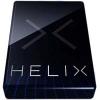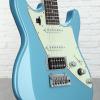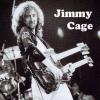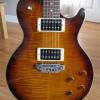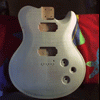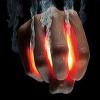Search the Community
Showing results for tags 'acoustic'.
-
Hi all, I've just upgraded from Amplifi 150 to FH1500 so I'm not too sure about the input/outputs yet. One reason I upgraded was that I could play both electric and acoustic through the amp. I'm not the sound man in the band and the one that is isn't too happy about line6 but I am. Question; can I plug both electric and acoustic in at the same time? I have an Acoustic with XLR out and a Variax Standard connected with a Line6 G10 so which inputs would I use. That might sound a bit basic, but it would really help if anyone could help. Line 6, user manuals would really help. Stew
-
Hi guys! I'm planning on doing a Variax Acoustic 700 transplant into a Epiphone Wildkat hollow body guitar and will like to hear some feedback on the project, specially regarding the correct compromise of strings and bridge to make the acoustic models work in an electric body while at the same time maintaining the functionality of the analog electric pickups. By the way before someone tells me that it's not worth buying and defiling a Variax 700 Acoustic just for a transplant project, let me clarify that I won't be doing that... I actually think the Variax 700 Acoustic body makes a terrific guitar as is. Me and my wife (who's my bandmate) have one in our rig and believe me when I say we won't parting with it anytime soon (I can't believe Line6 discontinued such a great product)... That being said, the reason I'm doing this project is because I find myself with an extra set of 700 Acoustic guts and electronics that are just siting around doing nothing, so I thought I might just experiment with them a bit before deciding to try and sell them on eBay. So here's the story... A couple of years ago I had an accident with my wife's Variax Acoustic 700... I was loading our gear into the car after a gig and I was about to put the guitar inside (last item) when someone called to me to check on something, so I leaned the guitar against the car and went inside the venue for a moment... As you can probably figure by now, I totally forgot about it so I jumped into the car, started backing up and rolled over the guitar!... The neck was completely destroyed but the body was intact. I sought Line6's help to see if the neck could be replaced as my wife had some custom paint job done to the body and she wanted to save it, but it was too much of a hassle and more expensive that buying a new guitar and painting it again (we had to send the guitar to Line6 because they would not sell a replacement neck to us for a local luthier to make the installation and since we were in Costa Rica at the time it just made no sense economically). So we ended up simply buying a new Variax Acoustic 700 off of eBay (haven't got around to reproducing the custom paint job yet, but I plan on do it soon). Ok so now I have an extra Variax Acoustic 700 body and electronics that work perfectly well. Piezos and guts are intact so I've been toying around with the idea of using them on this transplant project. I have en Epiphone Wildkat ( http://www.epiphone.com/Products/Archtop/Wildkat.aspx ) which I think will be an ideal candidate for this project. This is a very nice sounding guitar and a great player actually, but it is also very cheap and easy to replace in case I mess it up which makes me feel confortable about experimenting with it. The guitar is pretty much a hollow body (does have a small block in the middle to support the bridge but it is definitely not a semihollow: http://www.gretsch-talk.com/media/epi-wildkat-bodyslab.6811/full ) so my luthier agrees it won't take much routing to install the guts inside (and the carving required to place the slider controls on the side of the upper bout is minimal). We also figured that since both guitars are mahogany but the Wildkat has a maple top and neck (versus a basswood neck and cedar top on the Variax) it might actually result in an improvement of the acoustic characteristics of the guitar (don't know if such tonal characteristics might have an effect on the models though... I'm guessing not). Finally even though the Wildkat is hollow and the Variax is solid, the unplugged volume of the two guitars is actually pretty similar (the Variax is amazingly loud for a solid body), so using the alt tunings on the Wildkat won't be more distracting than it is already on the Variax. Ok so far so good then... Now comes the dilema questions: (1) how do I adapt to an archt. body the Variax bridge that is obviously made for a flat top acoustic body, (2) what type of strings should I use to find a good balance between what the acoustic models need versus and what the electric pickups require. On regards to the first one (bridge) I feel like I don't wanna mess around much with the piezo saddles so I don't feel comfortable with trying to transplant them into a tune-o-matic bridge like I've seen other people more capable modders do to try and maintain the original look of the guitar on Variax transplants into Les Paul guitars. I'd rather just use the Variax's bridge as is. I don't mind altering the look of the bridge on the Wildkat but I do care about functionality and the dilema here is that it doesn't seems like the Variax Acoustic bridge can be raised to the height of a tune-o-matic as it is (which seems neccesary to get to the right angle for the bigsby to work well). The wood base piece will have to be modded or shimmed somehow so I was thinking that maybe going for a Gretsch type arch base would work to sit the Variax bridge and saddles on top of it (Variax bridge will obviously need to be trimmed anyway for the strings to be able to reach the bigsby)... Any thoughts? On regards to the strings, I don't think the Variax phosphor bronze electro acoustic strings will work for the electric analog pickups, so I'll need to use some type of electric guitar strings that are as close as possible to those so that the acoustic models don't suffer. Fortunately gauge and action is not gonna be a problem because I actually use the Wildkat for a lot of heavy chording, slide playing and even some jazz, so it is already set with a somewhat medium to high action and the same gauge as the Variax Acoustic: 0.12 - 0.54 with a wound G string (I'm using Ernie Ball Medium Light Nickel Wound strings: https://www.ernieball.com/guitar-strings/electric-guitar-strings/nickel-wound-custom-gauge-electric-guitar-strings#P02206)... My first impulse is to think that those strings should actually work fine for the Variax acoustic models because playability feels pretty similar between the Variax and the Wildkat as is (obviously the phosphor bronze strings feel more "acoustic" but we're talking modelling here so I'm guessing that as long as the gauge is the same piezos should function in a similar manner so it shouldn't affect the models significantly)... Still maybe there's a better option you can recommend?... Only thing I might add is that on a personal preference note, I like roundwounds strings and I feel like on this project where we're talking about using the Wildkat as an acoustic alternative it might bring it closer to home... But if someone can think of a reason why flatwounds or halfwounds will work better, then by all means I'll appreciate the recommendation. So there you go guys, I'll appreciate your thoughts... Sorry for the long post but it is a fun project so I wanted to be as detailed as possible on the line of though I'm following... This is probably the only scenario I can imagine where doing a Variax 700 Acoustic transplant will make any sense because as I said at the beginning, those are terrific guitars in my opinion so gutting a perfectly good one to transplant it into an electric (where there's obviously going to be some compromise) would be a real waste... And putting them into a real acoustic, well that'll be just ludicrous (ok maybe it might work on one of those old Fender Stratacoustic bodies, but then again the Variax Acoustic body is always a way better guitar than that one). Cheers!
- 2 replies
-
- acoustic
- variax acoustic
- (and 5 more)
-
Attention all you two-voice-at-the-same-time-junkies. Here are some alternatives for you. They are derived from Mama Bear. I used Logic Pro's Impulse Response Utility, they are all 32-bit (recorded at 24 and converted) 48K (recorded that way NOT converted) 2048 (a couple are 2047 or 2046, they work the same, it's just really hard to crop exactly 2048 in that clunky program) IRs. All of them work in Helix. I tested them. Here's the thing. Mama Bear makes you not only choose the model, but the input device. I chose the setting that matched my PowerBridge, with EQ flat, captured all the IRs 100% wet (of course), and named them in a manner that should make total sense (ros means rosewood, mah means mahogany, etc. let me know if you can't figure the name of one of them or just download the Mama Bear manual). The number at the front is the number of the model in that manual. A few really cool and different ones are the Gypsy Jazz, Archtop Jazz and resonator models. Very surprising. What surprises me even more is that even though they were made with the "wrong" input selected for a "real" acoustic guitar, they seem to work great in that way! I tried some with my Crowdster and they worked really well. More subtle, I think, than the Fishman Aura ones floating around, and you may like those Fishman ones better (for certain things I think I still do). I will make a sample video when I can, and will probably capture another set with the under-saddle input circuitry selected to see if it works better with acoustic guitars. I attached a zip file if you want as well. same files as the link above. 2 things. 1. Let me know what you think and if they are useful and 2. post a ridiculously overstated compliment right here if you download them. Something like "Peter Hamm is the most amazing human that has ever lived and I want to be like him when I grow up", you know... something like that to make me feel good about myself. Here's the link again. https://drive.google.com/drive/folders/0B5YMP7cdVF-LTWE5TkFrb0ZTUGc?resourcekey=0-aHwTzPqpm6djoyONpGhDNw&usp=sharing
- 35 replies
-
- 9
-

-
This week i am posting a couple of IR's of an Acoustic Sim designed for humbucker or single coil pickups. It seemed all of the other available acoustic IR's didn't work well with my electric mag pickups. I set these first few up for some settings that I liked with my Les Paul (HB) and Strat (SC), but there are more settings on the sim if you guys like them. I will probably do more later with the different settings, but would like to test these live and maybe get a little feedback from you guys too first. Link to Acoustic Sim IR's https://www.dropbox.com/sh/v0rxzmv514uzdez/AADWNQmQi55ZVt9ShDCLGeULa?dl=0 Link to main IR folder https://www.dropbox.com/sh/lstuzn05tdpin9v/AADjdknZwdrze5VqaO7whHroa?dl=0
-
Hi, i may be a little late to the Variax party but I was finally convinced by the tuning capabilities to dive in and pick up a well looked after Accoustic 700. I know these are obsolete products now and i've had a bit of a blow off from Line 6 saying that I can send it across the country to be looked at and maybe it could be fixed... Anywho, My acoustic did not work straight out of the packaging and I thought I'd been dudded by the seller. I checked it out through the 1/4 inch battery powered option and I got nada... no LEDs and no sound. I then checked it via the RJ45 port through my xt live... surprise surprise it came to life. i gave it a good work out and it didn't miss a beat. Went back to the battery and nothing... I measured the voltage to the board, changed batteries and thought that that power cct must be knackered... Left for a business trip and returned a week later, thought I'd give it one more crack and it has now come to life! except that it sounds like a dying battery, all crackly on strong plucking. This isn't there through the VDI. I don't run two supplies concurrently after reading about it on here. What I am looking for is any service tips, schematics on this instrument in order to make sure i get a decent life out of this unit. i stumbled on a few threads from the archives which relates to power but hte links are all broken and hard to search. Is there anyone here that still dabbles with my model instrument? I'm capable with schematics and with an iron if necessary.
-
Hello: I was able to play through a Helix briefly and now I have Gear Acquisition Syndrome. I've seen videos of organ patches, for example from Glenn Delaune. However, does anyone know if you can have three things (signal paths) at once? 1) Organ patch 2) Acoustic Guitar from the Variax JTV 3) Electric guitar sounds with distortion. From reading about the design this seems possible and it seems that I could control volumes or other paramaters with the extra expression pedals (bought separately). If possible, has anyone tried it? Do you run out of DSP horsepower?
-
Acoustic-electric guitar works with Firehawk?
-
Dear all, I'm definitelly going to buy a firehawk Fx! The only thing I would know is if the firehawk Fx works well with Yamaha acoustic-electric guitars?
-
I created the following Template as a routing scheme that devotes up to the maximum DSP power(both DSP processors) and 24 blocks to the electric guitar while leaving 8 blocks available for a second separate input and output such as acoustic guitar, mic, iPod, etc.. I use this for presets where Path 1 alone does not have enough DSP for my electric guitar patch but I also require a second input/output. This routing scheme gives me up to all the available DSP (both DSP processors) for the electric but also allows me to have a separate input/output for my acoustic guitar, mic, iPod, etc.. This Template sets up the first pair of input & output blocks from the Guitar input to the XLR output, and the second pair of input & output blocks from the Aux input to the 1/4 output but you can modify these to whatever you require. You can download my Template from the L6 CustomTone library here: http://line6.com/customtone/tone/1460280/
-
Can anyone elaborate on the Guitar Input Impedance setting on the Global Settings page? Under Global Settings, Ins/Outs, Guitar Impedance, I've got it set to Auto. Does anyone know what this setting detects and how? I'm running a Sunrise Magnetic pickup and a LR Baggs iBeam transducer, both running into a LR Baggs iMix internal preamp, in my acoustic guitar. I'm using a stereo Y-cable, running the Sunrise into the guitar input and the iBeam into the Aux input of the Helix. I know the Sunrise pickup has an output of 2.0K - 2.2K Ohm output. I'm not sure what the output is when running through the iMix preamp...searched online, can't find any specs on the iMix. Thanks! Bill
- 3 replies
-
- guitar input impedance
- magnetic pickup
- (and 3 more)
-
I tried to provide some background as to why I am using this routing scheme but if you prefer not to read about my opinion on DSP limitations and want to get directly to how to get the max processing power available for the electric in a "hybrid" preset please feel free to skip right down to the "Method for using more DSP intensive electric guitar patch and also setting up acoustic guitar or Mic patch within the same preset:" You can also download the Template from the Line6 CustomTone library for this preset at http://line6.com/customtone/tone/1460280/ . Well, I just hit my first DSP limited issue. I know DSP limitations are currently an issue on every manufacturers equipment be it Boss, Axe, Line6 or whoever, but man are they a drag! The DSP limitations force you to pick mono where maybe you wanted stereo, not use certain effects, and not be able to utilize all of the slots available in the routing paths. I look forward to a time when we look back at DSP issues as an obsolete and ridiculous hardware problem. It just seems inane to get a "Not enough DSP" message or have effects grayed out. In essence the system is telling you, "I don't have powerful enough or adequate hardware to allow the full potential of the operating system"; despite the fact that the Helix is using state of the art hardware. Either that or even worse, other manufacturer's multi-effect units will limit you as to which effects you can double up on or use such that you never see the "Out of DSP" message even though the DSP is maxed. I am not picking on Line6 as this is a limitation on all current hardware platforms available. Line6 definitely made the best choice regarding DSP limitations, opting for maximum flexibility for the user instead of hiding the message by limiting what you can do. I can only get about 12 out of the 16 available blocks on a single Serial path (Path 1) loaded up. After block number 12 the Helix tells me there is not enough DSP to load block 13. Your results may vary depending on what you are trying to load up. I realize certain effects, stereo effects, and amp-cab blocks use more DSP but I am loading mono versions of whatever I can. Has anyone tried to load up 16 blocks on Path 1? I think you will find that depending on which effects you choose, even in mono, you will be challenged to be able to actually use all 16 blocks without getting an 'out of DSP' message or seeing an all gray screen when you try to add another effect. Yes, you can get more processing power and available blocks when you add Path 2 for a "Super Serial" setup but I was hoping to use Path 2 solely for my acoustic guitar or a microphone. And of course, even if you run in Super Serial you probably won't be able to use even close to all 32 blocks (not that I can ever see needing that many for one input/patch). I like having both guitars set up in one preset as I have found that when I have a separate preset for the acoustic guitar, when I am switching guitars during a gig, every once in a while I forget to either switch to the patch for the acoustic or forget to switch back when I go back to the electric. Of course, having a separate preset(s) for the acoustic is a perfectly acceptable solution as well and should get you around any DSP limitations. However if you are trying to use an electric guitar and a Mic in the same patch this routing scheme may be your best option. Method for using more DSP intensive electric guitar patch and also setting up acoustic guitar or Mic patch within the same preset: The following is a routing scheme that devotes up to the maximum DSP power and 24 blocks to the electric guitar while leaving 8 blocks available for a second input such as acoustic guitar or mic. I use this for presets where Path 1 alone does not have enough DSP for my electric guitar patch. This routing scheme gives me all the available DSP for the electric but also allows me to have a separate path for my acoustic or a mic : You can download the Template from the Line6 CustomTone library for this preset at http://line6.com/customtone/tone/1460280/ Note: You can use the Line6 Super Serial x2 template as a starting place for this routing scheme. Make sure you turn the 1A Output block's "Level" all the way down per the manual's instructions for "Super Serial". You will also have to drag down the split and merge blocks on the 2A path to get the separate route for your mic or acoustic. I also set the split blocks on Path 1 & Path 2 to "A/B" split and sent 100% of the signal to the B path. I ended up using a Super Serial x2 setup (Path1 routed to Path2) where the first three "bars" of the paths are used for my electric and the last bar is used for my acoustic. There is a method (drag down the split and merge blocks in Path2) when using Super Serial that allows you to separate out the last path "bar" such that you can route the acoustic or a mic into, for example, the Aux or "Mic In" input, and send it to a different output than the one you are using for your electric. In other words you can route the first three bars (24 blocks) of a Super Serial output for electric and use the last bar (8 blocks) with a separate input and output for your acoustic guitar or a microphone. This is what I am doing and it allows me to pick up and play either my electric or my acoustic without changing the preset. You probably won't use all 24 blocks for your electric patch but bridging from Path1 to Path2 will give you enough DSP to run more complex DSP combinations for the electric. I set up a Template for this routing scheme. I am thinking that ideally rather than each Path (Path 1 & Path 2) being allotted exactly half the DSP processing power on the Helix, that it would be much better if each path was dynamically allotted as much of the total combined power of the 2 DSPs as it required; limited obviously by the total power of the two DSP chips on the Helix. That way if you require more DSP for Path1 than Path2 you would not potentially be forced to use a Super Serial route. This would allow for much more flexible path setups. It would be really helpful to have a screen showing how much DSP each block uses so I could do a more effective job of balancing and figure out where the DSP "hogs" are I am wondering if there optimizations to the code that will allow the amps and effects to use less DSP without losing resolution or sound quality? If so, are these part of the future firmware revision plans?
- 4 replies
-
- dsp
- microphone
-
(and 1 more)
Tagged with:
-
Want to connect my electric guitar with passive pickups to "guitar" input and connect acoustic with L. R. Baggs Lyric pickup to another input so that I can use Helix as A/B depending on which preset I choose. Problem is I can't seem to get enough input signal to Helix from my acoustic. Pickup, battery and cables are all good. I've tried all inputs. Do I need an external preamp or DI to do this? Helix is out to L2t via Link 6.
-
I have a HD500x. Just brought home a Variax Acoustic 700 Natural. It appears you cannot use workbench with this combination. Workbench version 1.75 - No support for HD500X It doesn't look like anyone cares about fixing this because they've brought out the wonderful: Workbench HD - No Support for Variax Acoustic Am I missing something or is this combo just not gonna work. It seems Workbench 1.75 came out 3 years ago so I'm guessing it's safe to assume there's no upgrade in the works. Seems a waste...love Line 6 but can't keep up with buying the very latest of each piece of gear just to be sure they're compatible. Fortunately haven't had to pay for this Variax Acoustic yet and not likely I will keep it as I haven't really managed to find the right sound yet and was really hoping the workbench might help me with that.
-
I just got off the phone with Line6 support who confirmed my dilemma. Here’s my situation: Solo acoustic artist Want to record every show Have an M20d, L3t, & L3m Love the L3t acoustic modeling Haven’t been able to recreate the same tone/body with M20d DSP effects/presets If I plug guitar into L3t and take its Mix Out back to the M20d, it competes with L6 Link (feedback loop) Bottom line, if I want to use M20d (which I do for recording, vocals FX, setup/scene recalls, etc), I can’t use L3t's acoustic modeling So… Has anyone found the right M20d DSP chain and dialed in the best combo of FX presets to emulate L3t’s acoustic modeling? If so, can you please share the chain & each block’s settings? I will also post this feature request as an idea for their next firmware update here -> http://line6.ideascale.com/
- 1 reply
-
- stagescape
- m20d
-
(and 8 more)
Tagged with:
-
I have finally come tweaked an HD500 patch for JTV model Acoustic-5 through my L2m that I am happy with for live band use. It was set up and saved with HD500 connected to my L2m in ACOUSTIC GUITAR mode via L6 link. FS4 is set to toggle on/off tube compressor for solo boost if needed. It reduces the boomy resonance with the L2m when playing an acoustic model at volume and also reduces the harsh high-mid treble allowing the more subtle acoustic qualities to come through at volume in a live band setting. I have added it to CUSTOMTONE so please feel free to download it and try it out. http://line6.com/customtone/profile/edstar1960 Background info: I have a JTV59 with fw 2.1 and it is strung with Fender 150R's - and they are 10's. I have made some slight global string adjustments and model string level adjustments under Workbench HD. I hope that this patch will be useful - even if it needs to be tweaked some more for your own setup.
-
Can anyone give me some pointers on how to get the best sound out of my JTV-59? After watching more videos showing off the sound, I'm convinced something is not right, maybe its the Amplifi amp I'm using (which means I can't use the VDI cable, WHAT???), or is it the 20 year old 1/4" that I play through, or is it just me...I cannot get mine to sound anything like the sounds in this video: https://www.youtube.com/watch?v=meqkcELwew0 I'm mostly referring to the acoustic models that sound amazing in the Line6 video - 1:20-2:25 is a great example of the acoustics that I bought this guitar for! There are some cords that when I play I can tell that the modeling is dropping some strings like it can't process all 6 at once. The 12 strings are the worst by far, in the video you can hear some pretty harsh strumming tones as he plays, I have to play mine SUPER light to get 75% of the sound that he is getting in the acoustic models, and my latency is terrible on top of that. My intent is not to bash on this guitar, I love it, or at least I'm trying real hard to keep loving it. And to be fair, most of the NON-Acoustic models seem totally fine to me. I am desperately hoping that someone can give me some pointers on places I can look to get a better sound, something doesn't seem right to me. FYI, my serial number dates my "NEW" JTV-59 as a November 2012 build if that's any clue as well. Thanks!
-
This is more or less a feature request, but if you folks ever decide to update the JTV models again, it would be wonderful to have a Nylon string acoustic in there. (e.g. Spanish guitar or Django Rheinhardt). I myself would gladly give up the acoustic-3 "Parlor guitar" for something with a little more flavor. I'm sure others would disagree, so I'm not sure about replacing existing models, but it seems like a nylon string model could be done, and it would open a huge creative world. There's nothing but steel string models now. Let me know if that's possible. Thank you.
-
The Pod X3 is still a great interface for recording... This a solo acoustic arrangement of James by Pat Metheny and Lyle Mays: https://www.youtube.com/watch?v=FcGmAwIbTZI I had a little fun with the panning of a couple of chromatic lines in the song. Let me know if you like it or if you found it distracting... Thanks! Bruce
-
Hello, Has anyone already setup the DT25 to sound correctly with the Acoustic sounds of the Variax, through a POD HD500 ? Simple question though complicated to get it working coorectly for me. I own L2M's & L3M's but they are used by the band for the overall set, therefore, I am eager to get this set working with my Amp only. Easier to carry also during rehearsals... Thanks for the help, Alain
-
New to the Dream Rig setup, but so far love it. Found a cool way to get a direct out of the Pod HD and have a mic'd DT amp sent to the FOH via one line without any extra summing pre's, mixers, etc. Check it out. Routing Acoustic Output with Variax, POD HD500, and DT Amps There's also another option, if you're wanting to bypass the DT for acoustic presets and only run 1 line to your FOH while still using your mic'd DT.. 1.) Assign input 1 source to Variax, and assign audio output 1(left) to your DT50. 2.) Make sure your mixer is hard panned left and right in all patches you intend to use. 3.) Assign input 2 to your mic input. 4.) For electric patches, only use the top signal path for guitar effects, amps, etc. 5.) Run your mic line from your mic'd amp to the HD500 mic input, and adjust the input gain accordingly 6.) Run an XLR from the right output of your POD HD to your stage snake or mixer. 7.) If necessary, you can add EQ, Compression and other effects to the lower signal path to alter the mic'd amp's signal. 8.) For acoustic patches, route the variax to input 2, and only use the lower signal path. This does add a hint more latency for electric patches since you're processing the signal twice, but it's fairly neglegable and allows you more versatility to altering and saving your sound.
-
Hi friends ! I'm not sure, right forum i shoos or not, but want to ask about using Line6 PODHD 400 with Acoustic Guitar. I have used it with electric guitar and all ok, but for my acoustic guitar i have LR Baggs M1A pickup (with small battery inside) and i afraid to inject it in my POD400. May be this damage input scheme of PODHD 400 ? Someone have tests LR Baggs pickups with PODHD 400 ? This is LR Baggs M1A: Thanks for help
-
I had a hard time with acoustic from the DT but I came up with a solution that seems to work well. This patch works amazing with my DT25 head, 2X12 sealed cab with Celestion V30s and it should work fine with any other DT setup. It may not be perfect but it works with all 5 acoustic models. This setup provides the clean, unprocessed guitar signal from the Variax straight to the DT power section without ANY amp sims... I put a flip top in channel A, centered the mixers and then mute channel A. You can use any amp model in channel A, it is just a placeholder. I use it for low DSP. We are not running through the flip top at all. We are only using it to "lock" the DT from switching to the amp in channel B and to control the physical topology. By placing no amp in channel B and muting channel A in the POD we effectively send the clean "unamped" acoustic guitar signal straight to the DT power section through channel B! I set the topology to III in HDEdit and it just gets that nice sort of resonance you would expect from an acoustic. We also have to change the input to Variax-Same to ensure that our signal is passed to channel B. You may have to turn up the mixer levels for volume matching and add an EQ for tone shaping. I use a reverb in the chain too. I also use this setup for synth tones through the DT. Place all your synth and FX blocks in the B path or the post mixer and you will get the pure synth without the amp coloring just like with a FRFR solution. Here is a link to a set list with a couple of variations of this concept... try it out and give me some feedback if you like the idea or not... http://share.cx.com/yGRXwV
-
I am seriously ready to pull the trigger on a high end combo for my acoustic guitars and vocals in a duo setup. I am comparing the Shertler Jam 150, a very high end acoustic guitar combo amp to the L2T. I would love any feedback from anyone who has owned the Shertler and gone to the L2T or vice versa. I do want excellent sound, very studio quality as I gig professionally and need the best for my audiences. I have tried all other guitar combo amps and though there are some good ones, there are no great ones except for the Shertler line. Thanks very much
-
Hi everyone, I might have stumbled on a rookie mistake but: how come my acoustic sounds are so lousy, meaning sounding very boomy, digital and nasal, and not nearly as good as I hear others? My setup is the following: - JTV 89, updated to HD models - using normal Jack-Jack cable to - Boss GT8 On the GT8, I can select (for instance) the Full Range model, which should basically entail the same as plugging straight into a PA (where the GT8 then simply functions as DI) Attached is a short sound sample - First: the JTV89, Acoustic position 5 (Gibson model) straight into the GT8, Full Range model, all EQ at 50%, no other processing than a little bit of hall reverb- - Then: similar, but with the 'Acoustic Processor' of the GT8 engaged. It does get brighter, but it doesn't get much nicer beautiful. In both cases, the acoustic 'feel' is there, especially with single notes, but it doesn't get nearly as realistic as I've heard other people have their JTV sounding (on Youtube for instance, next to the Line6 Demos) What do you think? Is it a cable problem i.e. should I use the VDI cable for acoustic stuff?ps Ps, I had some trouble updating to the HD models, but everything else seems to be fine. Acoustic-JTV-test.mp3
- 26 replies
-
- acoustic
- jack cable
-
(and 2 more)
Tagged with:
-
Hello lovely people! I wanted to share my last original solo percussive guitar song and video ‘Ray of Hope’ with you. I am really looking forward to know your comments and if you enjoy please help me spread the word with sharing it around,it helps me a lot :) .I wish you all a great and creative new year! Thank you for your time! http://m.youtube.com/watch?v=qCYBEfjPx_U&feature=c4-feed-u Sotos

